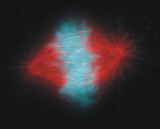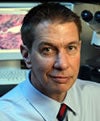Cell Structure and Function
 Research in cell structure and function seeks to determine mechanisms by which parts of cells undergo change and interact with one another in carrying out basic cellular functions. The field encompasses cell morphology, physiology, biochemistry, and molecular biology. The goals are to understand the organization and activities of cells at all levels,from the behavior of entire cells and cell organelles to relationships between their component molecules. A wide range of approaches is employed, including light and electron microscopy, electrophysiology, molecular genetics, and biochemical analysis. A number of rapidly developing areas are under investigation by members of the Cell and Molecular Biology group.
Research in cell structure and function seeks to determine mechanisms by which parts of cells undergo change and interact with one another in carrying out basic cellular functions. The field encompasses cell morphology, physiology, biochemistry, and molecular biology. The goals are to understand the organization and activities of cells at all levels,from the behavior of entire cells and cell organelles to relationships between their component molecules. A wide range of approaches is employed, including light and electron microscopy, electrophysiology, molecular genetics, and biochemical analysis. A number of rapidly developing areas are under investigation by members of the Cell and Molecular Biology group.
Mechanisms of cell motility, including movement of whole cells and of their parts, constitute an active area of investigation in cell biology. In recent years, there has been considerable progress in the structure and chemistry of microtubules, microfilaments, and membrane proteins. Research in these areas at the University of Virginia includes studies on the mechanism of chromosome movement during mitosis, of organelle tranport along microtubules and actin filaments, and on the behavior of flagella during cell motility.
Another important area of cell biology concerns the control of cell function by external signals. A major aspect of research at the University of Virginia relates to the function of cells involved in the circulatory systems, particularly the vascular smooth muscle and endothelial cells of the circulation. Techniques ranging from video microscopy to gene cloning are used to investigate the factors that control the circulation and growth of relevant cell types.
A source of information that is very important in determining the proper function, arrangement, and development of cells is provided by the extracellular matrix. This network of proteins and other macromolecules helps organize and inform cells of their locations, and provides guideposts for their migrations through an organism during embryogenesis and for wound healing. Several labs at the University of Virginia explore the extracellular matrix, its composition, and its effect on the development of cells and tissues.
Research into basic aspects of cell function address myriad topics, ranging from the mechanism of storage and secretion of proteins destined to be exported from the cell to the nature of sites that initiate chromosome replication. The diversity of experience and equipment available makes collaborative projects possible and facilitates interdisciplinary approaches to current projects.
Faculty in this area:

Casanova, James E.
Role of Arf family GTPases in vesicular transport and cytoskeleton assembly.
Cell Biology of bacterial pathogenesis.
The innate immune response to bacterial infection.

DeSimone, Douglas W.
Cell Adhesion and Adhesion-Dependent Cell Signaling in Vertebrate Morphogenesis

Isakson, Brant
Translating our discoveries in the microcirculation to tangible benefits in patients.

Kelly, Kimberly
Advancement in the design of imaging agents; molecular imaging and radiological sciences.

Kucenas, Sarah C.
The role of glia in the development, maintenance and regeneration of the nervous system

Leitinger, Norbert
Role of lipid oxidation products in inflammation and vascular immunology in atherosclerosis and diabetes

Li, Hui
Gene regulation in cancer, RNA processing; Epigenetic modification; Stem cell and development

Lu, Xiaowei
Wnt/PCP signaling in inner ear development Mouse models for human deafness Wnt/PCP signaling in neural tube closure

Mohi, Golam
Cell signaling, stem cell biology, molecular and epigenetic mechanisms of blood and breast cancers

Owens, Gary K.
Identification of Factors and Mechanisms that Regulate the Stability of Late Stage Atherosclerotic Lesions and the Probability of Thromboembolic Events Including a Heart Attack or Stroke

Peirce-Cottler, Shayn M.
Tissue Engineering and Regeneration, Computational Systems Biology, Vascular Growth and Remodeling, Stem Cell Therapies

Saucerman, Jeffrey J.
Roles of complex signaling networks involved in the regulation of cardiovascular function and disease

Stukenberg, P. Todd
Mechanisms of chromosome segregation in Mitosis and generation of Chromosomal Instability in tumors

Winckler, Bettina
Endosomal function and dysfunction in neurons. Development of the nervous system: cytoskeleton and membrane traffic in axon and dendrite growth.



















